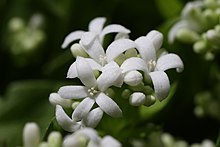Galium odoratum
This article needs additional citations for verification. (November 2013) |
| sweet woodruff wild baby's breath | |
|---|---|

| |
| Scientific classification | |
| Kingdom: | |
| (unranked): | |
| (unranked): | |
| (unranked): | |
| Order: | |
| Family: | |
| Genus: | |
| Species: | G. odoratum
|
| Binomial name | |
| Galium odoratum | |
| Synonyms[2] | |
| |
Galium odoratum, sweetscented bedstraw, is a flowering perennial plant in the family Rubiaceae, native to much of Europe from Spain and Ireland to Russia, as well as Western Siberia, Turkey, Iran, the Caucasus, China and Japan.[2] It is also sparingly naturalized in scattered locations in the United States and Canada.[3] It is widely cultivated for its flowers and its sweet-smelling foliage.[4][5][6]
A herbaceous plant, it grows to 30–50 cm (12–20 in) long, often lying flat on the ground or supported by other plants. Its vernacular names include woodruff, sweet woodruff, and wild baby's breath; master of the woods would be a literal translation of the German Waldmeister. It is sometimes confused with Galium triflorum and Galium verum.
It owes its sweet smell to the odiferous agent coumarin, and is sometimes used as a flavoring agent due to its chemical content.
Growth

The leaves are simple, lanceolate, glabrous, 2–5 cm (0.79–1.97 in) long, and borne in whorls of 6–9. The small (4–7 mm diameter) flowers are produced in cymes, each white with four petals joined together at the base. The fruits are 2–4 mm diameter, produced singly, and each is covered in tiny hooked bristles which help disperse them by sticking temporarily to clothing and animal fur.[7][8]
This plant prefers partial to full shade in moist, rich soils. In dry summers it needs frequent irrigation. Propagation is by crown division, separation of the rooted stems, or digging up of the barely submerged perimeter stolons. It is ideal as a ground cover or border accent in woody, acidic gardens where other shade plants fail to thrive. Deer avoid eating it (Northeast US).
Uses
As the epithet odoratum suggests, the plant is strongly scented, the sweet scent being derived from coumarin. This scent increases on wilting and then persists on drying, and the dried plant is used in pot-pourri and as a moth deterrent. It is also used, mainly in Germany, to flavour May wine (called "Maibowle" or "Maitrank" in German), sweet juice punch, syrup for beer (Berliner Weisse), brandy, jelly, jam, a soft drink (Tarhun, which is Georgian), ice cream, and herbal tea. In Germany it is also used to flavour sherbet powder, which features prominently in the novel, The Tin Drum. Also very popular are Waldmeister flavoured jellies, with and without alcohol.[9]
References
- ^ "Galium odoratum information from NPGS/GRIN". Germplasm Resources Information Network. Retrieved 2008-05-16.
- ^ a b Kew World Checklist of Selected Plant Families
- ^ Biota of North America Program
- ^ White Flower Farm (Litchfield Connecticut USA)
- ^ Monrovia Nurseries (Azusa California USA)
- ^ Royal Horticultural Society (London UK)
- ^ Gleason, H. A. & A.J. Cronquist. 1991. Manual of the Vascular Plants of Northeastern United States and Adjacent Canada (ed. 2) i–910. New York Botanical Garden, Bronx.
- ^ Altervista Flora Italiana
- ^ Sweet Woodruff Vodka Jelly
External links
- Galium
- Herbs
- Medicinal plants of Africa
- Medicinal plants of Asia
- Medicinal plants of Europe
- Angiosperms of Metropolitan France
- Flora of Western Asia
- Flora of Belgium
- Flora of Denmark
- Flora of Estonia
- Flora of Germany
- Flora of Greece
- Flora of Italy
- Flora of Latvia
- Flora of Lithuania
- Flora of Norway
- Flora of the United Kingdom
- Flora of Romania
- Flora of Canada
- Flora of the United States
- Flora of Spain
- Flora of Turkey
- Flora of Armenia
- Flora of Azerbaijan
- Flora of Georgia (country)
- Flora of Russia
- Flora of Siberia
- Flora of Iran
- Flora of China
- Flora of Japan
- Plants described in 1753
